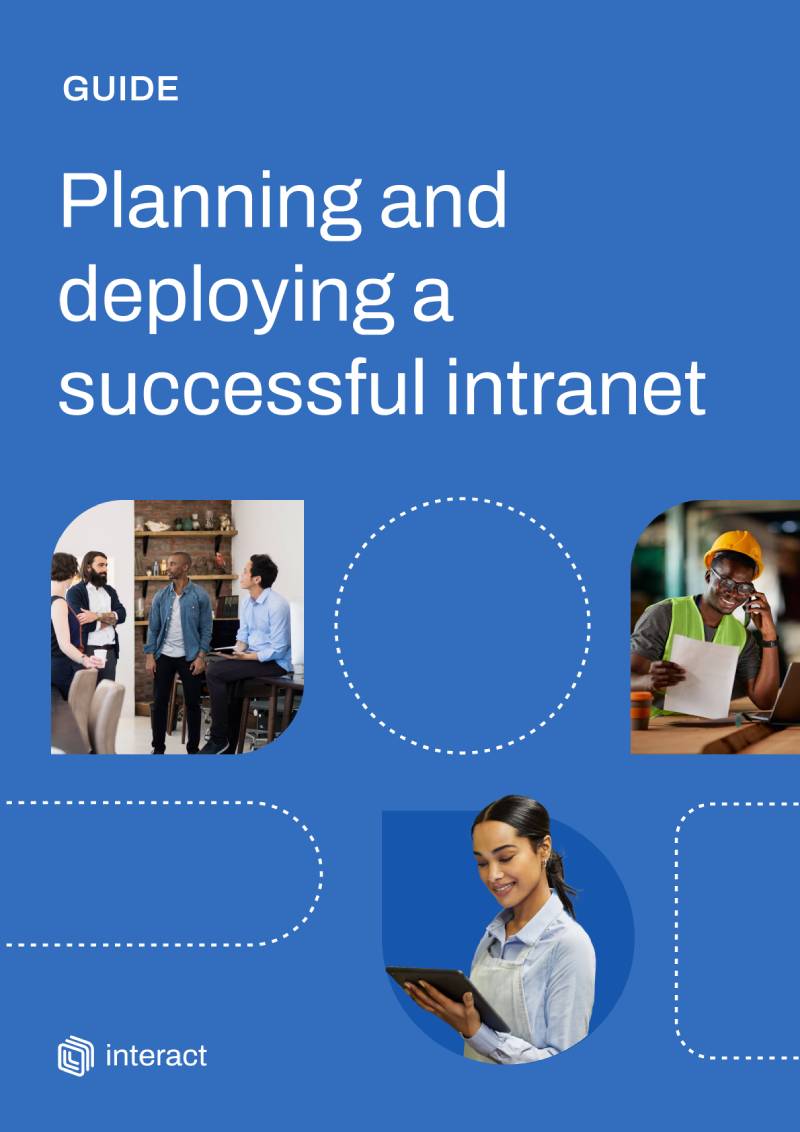The start of the year usually heralds the annual employee engagement survey. So, as we move into 2023, we look at how you can conduct an eNPS or employee engagement survey that enables you to build a complete picture of your workforce.
Whether you conduct them on an annual, semi-annual, or regularly recurring basis, an employee engagement survey is an important tool for HR, internal communications, and other people-centered teams.
An employee engagement survey not only helps an organization to tap into the thoughts and feelings of the workforce, but it can help to improve staff morale by enabling everyone to feel heard. Perhaps most importantly, the employee engagement survey is also a metric of a company’s success. According to workplace experts, Gallup, higher engagement scores are directly related to commercial performance.
Employee engagement is an even stronger predictor of performance during tough economic times.
Gallup
Tasked with improving your internal comms?
With working patterns still changing, how should you conduct an employee engagement survey in 2023? What questions should you ask that will encourage your audience to open up and provide valuable feedback to your organizational strategy going forward?
We look at the best employee engagement survey questions to ask in 2023.
Why are organizational surveys important?
As a major component of a comprehensive engagement initiative, an employee engagement survey offers several benefits:
Provides a ‘listening culture’: these types of surveys can measure the mood of the workforce but also allow employees to feel their feedback is valued. This is incredibly important to a sense of belonging in the workplace.
Provides a better understanding of leadership: If part of the survey focuses on managers and senior leaders, it can provide some valuable insights into the failings and successes of those people in charge. This critique can shape ongoing manager development programs.
Offers a place for frank opinion sharing: Not many employees feel comfortable speaking directly to their manager with a list of complaints. Surveys provide a platform for honest and anonymous feedback.
Employee engagement is more than a buzzword. The results from a Gallup poll show that it is business critical: Disengaged employees have 37 percent higher absenteeism, 18 percent lower productivity, and 15 percent lower profitability.
Highlights areas for improvement: Most business leaders would be happily unaware of the various issues within the workplace without the people on the floor highlighting them. This is valuable to the health of the business and the happiness of employees.
Helps develop foresight: Careful analysis of the survey will help you recognize trends, gaps, and disparities. This, in turn, enables you to spot issues before they turn into bigger problems.
Promotes trust and engagement: When employees can share their thoughts and feelings, even anonymously, they feel listened to. But when their feedback is acted on, they know that their opinion counts and can positively shape the business’s direction.
The role of the engagement survey in 2023
Work has changed significantly in recent years. Many more people work from home. There are more ways to communicate. The digital workplace has advanced rapidly in terms of integrations and productivity tools.
Just as importantly as the changes in technology, people themselves have reassessed what work means to them. This was most easily seen with the “Great Resignation”, a period of voluntary turnover that saw many more individuals leaving their jobs in favor of different kinds of work or early retirement.
For those who remained with your company, or who have joined in the past few years, this period may have encouraged them to ask questions about their aims and ambitions. Are they happy in their work? Are they fulfilled? Are they satisfied with how the business is changing? To reduce employee turnover and keep key workers and knowledge, employers are conscious of the need to listen carefully and act meaningfully.
89% of HR Leaders surveyed agree that ongoing peer feedback and check-ins positively impact their organizations.
SHRM/Globoforce Employee Recognition Report
Therefore, your employee engagement survey is critical to picking up on the current mood and building an optimistic but pragmatic framework for the future. The raw but necessary feedback should be used to draw up plans, reassess the status quo and reimagine the workplace. Using software that ensures anonymity, employees should be invited to share their thoughts and feelings about all aspects of the business – from their views on senior management to whether they support the organization’s core values. A large number of your workforce will already have these opinions fully formed – now is your opportunity to let them share them.
Tasked with improving your internal comms?
It is important to understand:
How employees are feeling and coping: the collective mental health has suffered during the pandemic. As employers, we have a responsibility to safeguard our employees and keep channels of communication open to encourage frank conversations regarding mental and emotional wellbeing.
If they’re still aligned to the business and their immediate teams: the decision to move work remotely was made quickly and under duress. There was little preparation for it. As a result, there are still areas of the relationship between the employee and the workplace that require close attention.
How to support them appropriately: Business leaders are still working out what the future of the workplace looks like. As a result, employees’ requirements are still evolving – and organizations need to understand what is needed, directly from the workers themselves.
Setting up this feedback loop will support our staff in the current circumstances and ensure we have solid foundations for the long-term.
Employment engagement survey vs. Pulse surveys
There are a number of ways to gather all-important feedback from employees, and it’s important to remember that employee engagement surveys are just one of many. Amid the questionnaires, in-depth surveys, one-to-ones, and other engagement practices that you employ, pulse surveys are also a recommended method. But what’s the difference, and when should you deploy each one?
Put simply; pulse surveys are light-touch, time-friendly questionnaires that get sent intermittently across businesses. They can come in the form of a poll, a YES/NO question, or eNPS score. These are sent unannounced, usually as a pop-up on the intranet homepage or through email. The ease of a pulse survey offers many benefits, but they should be used as part of a broader engagement initiative.
Combining pulse surveys throughout the year with a deeper, more probing annual employee engagement survey will ensure a more well-rounded insight into the thoughts and feelings of your workforce.
The changing face of employee engagement surveys

For the majority of organizations, the questions in an annual employee survey are fairly broad. They focus on aspects of working relations between co-workers and managers and whether there’s any room for improvement in office-based comms. They are based on an average employee working in an average office, for example:
- “How happy are you at work?”
- “Are you aware of what constitutes good performance in your role?”
- “Do you receive meaningful recognition for doing good work?”
- “Do you feel comfortable giving opinions and feedback to managers?”
These are just examples lifted from a standard employee engagement survey. Sample questions designed to tap into the workforce’s engagement levels and aimed at gauging the happiness and job satisfaction levels, in ‘normal times.’ However, we are not living in normal times. The landscape of work has altered dramatically, and so, in order to be effective, your engagement survey questions need to reflect the current status quo.
This may well result in the tearing up of the traditional employee engagement survey blueprint and starting afresh, to address the needs and concerns of a hybrid workplace, covering areas such as:
- Mental health
- Leadership and communication
- Remote working
- Relationship with managers
The outcome of your survey will only be beneficial when you readjust the lens of your survey and zone in on the areas that are impacting working life.
The employee engagement questions to ask in 2023

Working on these areas allows us to form an employee engagement survey relevant to the workforce of 2023. With questions that focus on these areas, it highlights to the audience that the organization is conscious of the present issues and is working to overcome them.
Mental and emotional wellbeing
Mental health is a big, complicated area. The survey isn’t meant to fix anything right now, but to work out what condition employees are in and how your organization is currently managing their feedback. Some questions you may want to ask your audience include:
- How would you score your current mental wellbeing? (Excellent – Poor scale)
- I feel safe at work (Strongly disagree – strongly agree scale)
- The company enables me to enjoy a good work-life balance. (Strongly disagree – strongly agree scale)
- I have enough opportunities to speak about my concerns and feelings. (Strongly disagree – strongly agree scale)
Leadership and communication
The past few years have shone a spotlight on leadership and communication. As businesses adapt to hybrid working, senior leaders and comms professionals have had to re-work their relationships with their teams. Questions that are relevant to this include:
- I trust our leadership team to make decisions that protect my colleagues and me
- Leadership visibly role model the behaviors they’ve asked of us
- I am receiving the right amount of communication
- I receive comms through the right channels
- I would like to hear more about certain topics
Remote working

While the shift to remote and hybrid working has been successful many, to make it work long term organizations need to listen to employees about their experiences of it. It’s recommended that text boxes are assigned to these questions to allow people to provide more in-depth responses:
- Has working from home affected your productivity?
- Do you have the tools needed to work effectively from home?
- What changes, if any, would help you to be more productive working from home?
- How often would you prefer to come to our closest working location to you?
Relationships with managers

Arguably one of the most important relationships in a business, the communication between managers and employees needs to be open, honest, and supportive. It is the manager’s responsibility to keep the team cohesive, informed, and harmonious.
This relies on open communication, and trust. It also requires the manager to take on a leadership role, leading by example, and encouraging the growth and development of each team member. The arrival of en-masse home working has put some relationships to the test, and it’s important to work out how and why. Some questions you may want to ask include:
- Do you have enough contact with your manager?
- Does your manager provide you with enough support?
- Do you feel able to talk frankly about work-related issues with your manager?
- Does your manager offer productive feedback?
- Does your manager inform you of important changes in the company?
2023 will be another year of change in the workplace
This year’s survey will probably look a lot different to previous years. It might take a different approach on length or frequency. It nay ignore a lot of the usual questions and focus on current and future events. All of this is not only fine, it’s recommended.
The feedback you receive is incredibly valuable advice. Not only is it free, but it’s from people who know your business intimately. So while carrying out an annual survey is essential, what you do with your feedback counts, and contributes to moving your business into a period of greater success.


